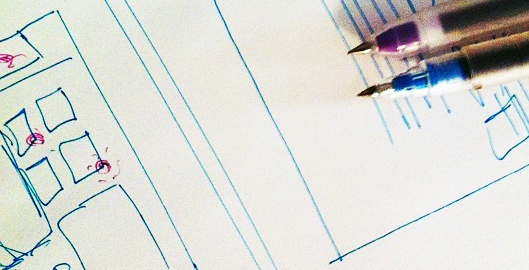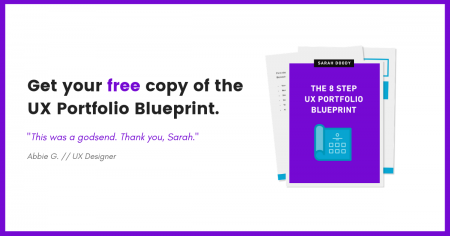
Looking to for help with you UX portfolio? Get my free UX Portfolio E-Book.
The number one thing people ask me is how they can get started in UX.
I’m always surprised at the volume of requests I get because I thought that there were a lot of resources already out there about getting started in UX. But when I commented about this to a friend, she just laughed and said there really aren’t enough resources because it’s all about voice and approachability. I guess it makes sense, sometimes five people can tell you the same thing and it isn’t until the fifth one that things make sense and you actually “get” it.
I do my best to respond to every request with either some useful links or more personal thoughts. But with requests becoming a daily occurrence, I thought I’d just compile my advice and my story.
I’m sure some of it will seem repetitive, but hopefully, it will connect with some people and help them have that “ah-ha” moment they’re looking for.
So I’m starting a new series on my blog called Getting Started In User Experience. Every Friday, I’ll share stories and offer advice to people just starting out. Of course, I would love it if you’d leave comments and tell me what topics you’re interested in me covering.
To start off, here’s the story of how I ended up in user experience design.
How I Got Started In User Experience Design
The truth is, discovering the field of user experience was a complete accident that only now in hindsight makes total sense. I didn’t even know the field existed let alone what it was called!
I originally was going to study neuroscience in Canada (where I’m from). Why neuroscience? Honestly, I wanted to be in medicine but I wasn’t sure about all the blood and gross stuff. During my last year of high school we had to do a big research project for a biology class. So, I did mine on biofeedback and somehow convinced a medical equipment company to give me a biofeedback machine for my project. This, is how I fell in love with the field of neuroscience (and also when I realized it would be probably be a good fit for me as it seemed like the least gory part of medicine).
But, after being accepted to the top school in Canada for neuroscience, I did what every 18 year old with dual citizenship does. I left Canada and came to the United States for the main reason that I just could.
During my first year of college, I got an internship at a small web design shop (because I had decided to study marketing of all things). On my first day there, someone gave me a copy of Dreamweaver 2 and Photoshop and told me to make a website about something I was interested in. So I made a little website about a fictitious ski area (sadly, I don’t have it anymore!!!). I know I completed the site within my first day because I remember the shock on the people’s faces when I told them I was done. I think they thought it was going to take me days to make that site.
To make a long story short, I focused on web and graphic design for a while. Then one day, I started to get into front end web development. I can’t remember how it came about, but I think it probably happened with the realization that if I knew how to code it, then I would be more informed as a designer. Also, if I could code, I would be able to maintain the integrity of what I designed. In other words, if I was coding it, no detail would be lost in translation from design to code.
For example, we were working on a travel website and I wanted the design to have many circular components. The problem was, HTML is based on tables that don’t lend themselves to circles very well (note, this was over a decade ago). So, when I showed my colleagues this design, they looked at my like was insane. But I thought they were the crazy ones. Obviously we could do circles, we’d just cut up the circle into graphics that we’d assemble in table, just like putting a complex puzzle together. Pretty simple to me. For some reason, that moment is engrained in my brain. I think it’s because it was probably when I realized that design was the best opportunity to use both the left and right sides of my brain every single day.
In hindsight, I can say that I am so, so, so thankful for the opportunity to learn to code. I am pretty sure it’s the single best thing that ever happened in my career. Although I would never tell a client I could code anything for them, what’s important is that I am technically literate. Being technically literate has also made it much easier to foster important relationships with developers which is critical if you are working on a project or in an environment where you have access and opportunity to collaborate with the technical team.
After doing design and coding for a while (and studying marketing), I realized that there must be someone who came before design — someone who helped shape the vision and the story of the user.
Around the same time, someone gave me a copy of a book on Information Architecture and said they thought I should read it. So I read it in a weekend and then I knew that’s what I wanted to do. I wanted to be at the intersection of business, technology, and design.
I wanted to help define design, I didn’t just want to execute the design.
Going Corporate
Early in my career, I was offered a full-time job at a Fortune 500 software company. So I enrolled in online classes so I could take the job and still finish my degree. I had my own office with a window and great view. I had access to a conference budget. There was a snack cart that a lady wheeled around at about 2pm every day. At the time, I thought it was such a great opportunity (it was) because it was what I thought was a “real” job.
I will never forget my first day, I had to design an animated gif banner ad for some type of printed circuit board (don’t ask!). Designing banner ads was news to me and I was not excited about it at all. In fact, I had never created an animated gif before in my life. I remember hearing “that voice” in my head and thinking “oh no, this is what I’m doing”. But, it was only my first day and quitting wasn’t an option, so I figured out how to make an animated gif banner ad (and many more in the future), ignored that voice, and ended up staying at the job for nearly 4 years.
I learned so much in my time at that big adult corporate job while I was in my very early twenties. Seeing how a Fortune 500 company-operated and being exposed to such big projects, process, and personalities was so foundational to learning how to manage clients and projects.
I also very much learned what I didn’t want to do. I didn’t want to be at the same company for 20 years. I didn’t want to just have people send me emails asking me to “spiff up” the design. I didn’t want to be a part of a conveyor belt. I wanted to have more influence. I wanted to create.
One of my first managers had this saying he’d always tell us, it went like this: “Know your tool. Know your tool as well as you can. Know your tool as fast as you can.”
I’ve always remembered that, and as someone starting their career, I guess I really internalized it because looking back, that’s exactly what I did. As I moved through this natural progression from design, to coding, to user experience I made a choice to become as good as I could be at each discipline.
Anyone who worked with my during those early years would tell you that I had two famous things I’d always say …. “I have an idea” or “I have a question”. I was always staying curious, trying to understand, and trying to become the best at what I was doing.
So if you’re just starting out, I’ll leave you with these two ideas:
Look beyond the immediate. At times, you’ll end up doing things that don’t make sense, things that seem pointless, and a waste of your amazing talent. But the truth is, in 2 years you’ll probably look back and see how all your experiences built upon each other to get you to where you want to be.
Be your best. I know its cliche. But it’s true. If you really want to build a career, figure out how to be the best and do it as fast as you can. Also, remember that being the best doesn’t mean being perfect.
